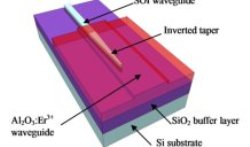Many semiconductor researches are being conducted worldwide to find materials that have good amplification properties. Optical microchips made from silicon remain as the optical channel for conducting light and it is amplified with the help of splitters and couplers.
 Image of the chip including silicon optical waveguide (SOI: silicon on insulator) as well as erbium-doped aluminium oxyde
Image of the chip including silicon optical waveguide (SOI: silicon on insulator) as well as erbium-doped aluminium oxyde
Gallium arsenide has a good amount of amplifying capacity and it is also used for making semiconductor chips. Silicon and gallium arsenide, in spite of their amplification properties, can only perform passive conduction of light and have demerits while amplifying a signal or in the process of adding a light source on a microchip. Extensive studies on materials with good amplification property have brought out the high amplification property of materials doped with erbium.
Laura Agazzi, a PhD candidate of the University of Twente. has made a study on the optical properties of aluminium oxide doped with erbium. In her thesis titled, “Spectroscopic Excitation and Quenching Processes in Rare-Earth-Ion-Doped Al2O3 and their Impact on Amplifier and Laser Performance,” released on September 20, she has effectively brought out the amplification property of these materials that have high energy-transfer up conversion (ETU). As these materials have the danger of being exposed to high interactions with erbium ions, she focused her research on materials that minimize the reaction of erbium ions. She was successful in making a chip that is integrated with silicon and erbium for the first time in the history of optical microchips.
The prototype chip has the amplifying capacity of 170 Gbit/sec and able to gain signal of 7.2 decibel at infrared light (1533 nm). This will make the possibility of emission of light that is as narrow as 1.7 kHz. Ms. Agazzi assured that the prototype chip, if put to use on a large scale, can be beneficial not only to telecom market but also in sensor applications for tracing minute particles.